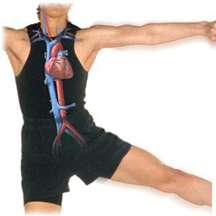Total Therapy Blog
Training Principles… Interval Training
 In the previous month, we took the time to talk about the different aspects of training and preparing yourself for a long-distance run such the Vancouver Sun Run. Starting this week and the following week, we have a new short series on those who are looking to get back into shape for summer but don’t know where to start. There are many training principles out there that you can follow, but which one is suitable for you? This week, we explain the technique Interval Training. We can’t stress it enough that not all training techniques are suitable for everyone, so it is important to consult your physician before trying any type of exercises we talk about.
In the previous month, we took the time to talk about the different aspects of training and preparing yourself for a long-distance run such the Vancouver Sun Run. Starting this week and the following week, we have a new short series on those who are looking to get back into shape for summer but don’t know where to start. There are many training principles out there that you can follow, but which one is suitable for you? This week, we explain the technique Interval Training. We can’t stress it enough that not all training techniques are suitable for everyone, so it is important to consult your physician before trying any type of exercises we talk about.
Do you ever find yourself saying, “Gee, I wish I could find the time in my day to exercise”? Welcome to the club! Many people find it difficult to work in an hour to an hour and a half of exercise two to three times a week. As a result, many people choose not to exercise at all, figuring they need to go “all or nothing”. Well fear not! You may not have the time to go for an hour long run, but you can get the same benefit from a much shorter interval using a particular technique. This type of technique is called interval training.
 So what is interval training? Interval training involves high intensity exercise for a short duration of time followed by a rest interval. This combination of a high intensity interval followed by a rest interval is then repeated a given amount of times. This week we’ll discuss some interval training strategies with respect to cardiovascular exercise such as running, biking, and even swimming, and over the next articles, we will give you some tips and strategies to incorporate into your own gym or home workout routine.
So what is interval training? Interval training involves high intensity exercise for a short duration of time followed by a rest interval. This combination of a high intensity interval followed by a rest interval is then repeated a given amount of times. This week we’ll discuss some interval training strategies with respect to cardiovascular exercise such as running, biking, and even swimming, and over the next articles, we will give you some tips and strategies to incorporate into your own gym or home workout routine.
You might wonder, “Ok, so how does this work?” Canadian researchers have shown that interval training increases the activity of certain enzymes; namely, enzymes that regulate how much energy the body can produce. While the testing protocols they used were more extreme than I would recommend to any casual exerciser, their testing showed that short bursts of sprint interval training (anywhere from 15 to 40 minutes), have the same benefits of traditional endurance training. This is great news for those of you struggling to find time to get exercise time in!
 Below are three interval runs or bike rides you can try. A few things to keep in mind though: these intervals are recommendations and may not work for you. That’s OK! The “take-home message” about interval training is that you work at a higher intensity for a shorter duration, and follow that with a similar duration of rest. It is also important to keep in mind that interval training has only been scientifically tested on young, healthy individuals (particularly the second and third intervals below), so consult your physician before trying this type of exercise.
Below are three interval runs or bike rides you can try. A few things to keep in mind though: these intervals are recommendations and may not work for you. That’s OK! The “take-home message” about interval training is that you work at a higher intensity for a shorter duration, and follow that with a similar duration of rest. It is also important to keep in mind that interval training has only been scientifically tested on young, healthy individuals (particularly the second and third intervals below), so consult your physician before trying this type of exercise.
The 2-2 Interval
This interval takes more time to complete (between 28-40 minutes not including a good dynamic warm up and cool down stretch), but involves a lower intensity than the second and third intervals below. Run (or bike) for two minutes at a pace that you could not keep up if you were to run for three minutes. After the two minutes are up, slow yourself down to a walk for two minutes. Then repeat the four minute cycle. Each four minute cycle is one interval. Work towards completing 7-10 intervals.
The 60-60 Interval
This interval is shorter in duration (about 14-20 minutes not including a dynamic warm up and cool down stretch), but the intensity is ramped up quite a bit, and you get less of a break between higher intensity intervals. Run or bike for 60 seconds at about 65-70% of your maximum speed (or, a pace that you couldn’t keep for a minute and 30 seconds), and then slow down to a light speed walk for 60 seconds. Try repeating this interval 7-10 times.
The 30-60 Interval
This interval is the shortest (about 11-15 minutes not including a dynamic warm up and cool down stretch), but the intensity is even higher than the previous interval. Run or bike for 30 seconds at about 80% of your maximum speed (or, a pace you couldn’t keep up for 45 seconds), and then slow down to a walk for 60 seconds. Try repeating this interval 7-10 times. This interval is exhausting when done correctly, so ensure you listen to your body and know how much to push yourself. Remember: consult your physician before trying any of these intervals.
Conclusion
 Interval training is a very simple concept. The above are only guidelines that you can try to incorporate into your own gym or home workout routine. But the take home message for today is that interval training involves high intensity bouts of exercise following a rest period. Taking this training principle, you can alter the above guidelines to fit your own routine. But remember, although these techniques have been scientifically tested, they have only been proven to be most effective for young, healthy individuals, so please consult and get clearance from your physician before trying any of these exercise techniques!
Interval training is a very simple concept. The above are only guidelines that you can try to incorporate into your own gym or home workout routine. But the take home message for today is that interval training involves high intensity bouts of exercise following a rest period. Taking this training principle, you can alter the above guidelines to fit your own routine. But remember, although these techniques have been scientifically tested, they have only been proven to be most effective for young, healthy individuals, so please consult and get clearance from your physician before trying any of these exercise techniques!
What kind of training techniques do you employ and have you seen any benefits from using your technique?








Follow Us!
& Stay Up To Date
BLOG